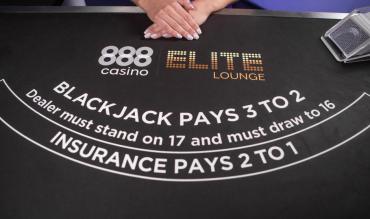Basic strategy charts tell us the best average play for every possible blackjack hand. That doesn't mean you'll always win when you make the right moves. It's just that when you add up wins and losses over many plays, your average return will be better when you make the basic strategy play than when you don't.
That's every bit as applicable to online play as to live casinos. Online, where you can't count cards, basic strategy play is the gold standard.
Still, many players think certain basic strategy plays feel wrong. Is it really best to split 8s and risk a second bet when the dealer has a 10-value card face up? When you have a hard 16 and the dealer has 7, wouldn't it be better to stand and let the dealer chance going bust than to hit and risk busting yourself?
All casino games are based on math, and blackjack math says the basic strategy plays are the way to go unless you're counting cards and know the composition of the deck dictates a switch.
There's a cost to veering away from basic strategy. Let's take measure in dollars and cents of some commonly misplayed hands.
Assume a game under a common set of rules: six decks, dealer hits soft 17, blackjacks pay 3-2, double downs permitted on any first two cards, double downs permitted after splitting pairs, pairs may be split up to three times except Aces, which may be split only once, surrender is not allowed.
Let's run some numbers on commonly misplayed hands.
➔ 8-8 vs. Dealer's 10
It might seem like throwing good money after bad to start two hands with 8 each when the dealer has a 10 up. But playing the hand as hard 16 is far worse.
Your average result will be negative no matter what play you make. If you hit, your average loss will be 53.5 cents per dollar wagered. If you stand, the average loss is a little higher at 53.7 cents.
Split, and your average loss dips to 47.6 cents per $1 of your original bet. That's not 47.6 cents times two, it's an average of 23.8 cents for each of your two hands.
Sometimes your fears will be realized, you'll lose both hands and your loss will be double your original wager. But there will be enough times you win both hands for a big win, win one hand and push on the other for a win the size of your original bet, win one and lose the other for a push or push on both hands that your average loss is smaller than if you hit or stood.
➔ Hard 12 vs. 2
It can be a queasy feeling when you draw a card to a hand that can be busted with a one-card hit. You know the dealer is going to have to draw. There is no card the dealer could have down that would turn a 2 into a standing hand without a draw. So why not let the dealer take the bust risk?
Answer: The dealer doesn't bust often enough for you to sit and wait. Average losses are lower if you hit than if you stand.
If your 12 consists of 10-2, the average 28.9-cent loss if you stand dips to 25.2 if you hit. Average losses with 9-3 are 28.6 cents for stand and 25.6 for hit. With 8-4 they're 28.5 for stand and 25.5 for hit; and with 7-5 they're 28.2 for hit and 25.4 for stand. With 6-6, split the pair instead.

➔ Hard 16 vs. 7
Players who have no trouble hitting 16 vs. 10 sometimes draw a line at 16 vs. 7, thinking the dealer has a great enough chance to bust it might be better to let that play out.
Actually, it's more important to hit 16 vs. 7 than against 10. Dealers’ standing hands tend to be lower when starting with 7, giving players more opportunity to win with a hit.
16 vs. 10 is such a close call that card counters sometimes stand as a camouflage play to let casinos think they're less than a basic strategy player. Average losses are 54.1 cents per dollar if you stand and 53.5 if you hit. With 9-7, averages are 53.7 for a stand and 53.5 for a hit. Differences are tiny, putting 16 vs. 10 firmly in close call territory.
But 16 vs. 7 is not a close call. With 10-6, average losses are 47.7 cents per dollar wagered if you stand while dropping to 40.9 cents if you hit. If you start with 9-7, averages are 48.1 cents by standing or 40.8 by hitting. Differences are large enough that you shouldn't even think twice before hitting.
➔ 11 vs. 10
Basic strategy charts tell us to double down in situations where we have an edge we can exploit. That includes two-card 11 vs. a dealer's 10.
Players sometimes shy away from this one for fear of being stuck with a weak card on their one-card draw when any 7 or better can give the dealer a standing hand. Sometimes you will lose two bets at once when you double down. That's always a risk.
But the average result is that doubling on 11 vs. 10 will increase your profits.
If you start with 9-2 vs. a dealer 10-value, the average result of hitting is a profit of 11.7 cents per dollar wagered. Double down, and that increases to 17.4 cents per dollar of your original wager.
Increases are similar with other 11s, going from 11.8 to 17.7 with 8-3; 11.8 to 17.8 with 7-4; and 11.9 to 17.8 with 6-5.
You don't double your profit. Inability to take a second hit when doubling is a limiting factor. But you do see a nice average increase in profit that makes doubling 11 vs. 10 worth the risk of sometimes losing two bets.

➔ Ace-7 vs. 9
Basic strategy calls for players to hit soft 18 when the dealer shows a 9, 10 or Ace.
Many players struggle with those plays, thinking of 18 as a solid hand. But on average, 18 is a loser when the dealer shows a 9 or higher. When your 18 is soft, you can hit without busting on the first card, and if you get a bad draw, you can hit again.
Soft 18 vs. dealer 9 gives you the biggest gain among these hands. If you stand, you face a loss that averages 18.3 cents per dollar wagered.
If you hit, you cut that loss almost in half to 9.8 cents.
The other two cases are closer calls. With Ace-7 vs. 10, hitting trims average losses from 18.0 cents to 14.3, and if the dealer has an Ace up, averages are 22.5 cents if you stand and 16.0 if you hit.
➔ Blackjack vs. Ace
When insurance is offered, there's a great temptation to call for even money. You win an amount equal to your wager without risking a push should the dealer have a 10 value down to match your blackjack.
That would be a break-even play if a third of the cards were 10 values, but only 30.8 percent are 10s, Jacks, Queens or Kings. Percentages change as cards are dealt, but only card counters are in position to take advantage of an unusual run that leaves 10s as more than a third of the remaining cards.
For most of us, it's important to understand taking even money means a profit of $1 per $1 wagered. If you skip the insurance and wait for the dealer to play the hand, you'll push sometimes, but you'll win enough 3-2 payoffs to show an average profit of $1.43 per dollar wagered.
Like other basic strategy plays, waiting and hoping the dealer won't turn up the wrong card might put you on edge. But if you want to give yourself the best shot to win, the math can guide you to the best decision.


